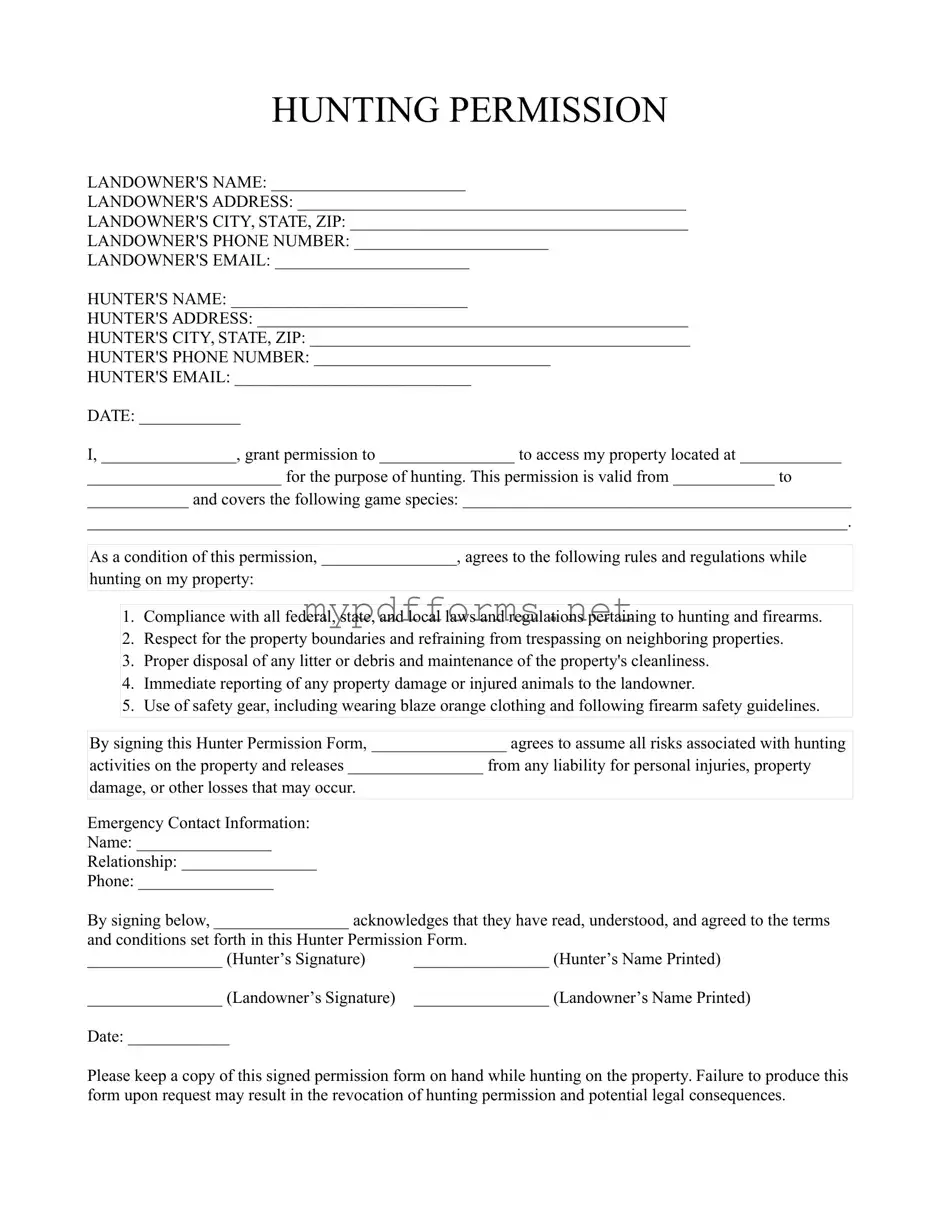The Hunter Permission Form shares similarities with a Fishing Permission Form. Both documents serve to grant access to private property for specific recreational activities. In the Fishing Permission Form, landowners specify the terms under which anglers can fish on their property, including the duration of permission and any rules that must be followed. Just like the Hunter Permission Form, the Fishing Permission Form emphasizes the importance of respecting property boundaries and adhering to local regulations. It also includes a liability waiver, protecting the landowner from potential claims arising from fishing activities.
Another document akin to the Hunter Permission Form is the ATV Use Agreement. This form allows landowners to permit individuals to use all-terrain vehicles on their property. Similar to hunting, ATV use can pose risks, so the document outlines safety guidelines and rules that users must follow. It includes details about the duration of permission and requires users to acknowledge their understanding of the risks involved. Both forms aim to ensure that recreational activities are conducted safely and responsibly on private land.
The Camping Permission Form also bears resemblance to the Hunter Permission Form. It grants individuals the right to camp on a landowner's property, specifying the duration of stay and any conditions that must be met. Just like the Hunter Permission Form, it includes a section for emergency contact information and a liability waiver. Both documents emphasize the need for campers or hunters to respect the property and leave it in good condition, ensuring a positive experience for all parties involved.
Similarly, the Trail Access Agreement is comparable to the Hunter Permission Form. This document allows individuals or groups to access trails on private property for hiking, biking, or horseback riding. Like the Hunter Permission Form, it outlines the rules and regulations that must be followed while on the property. The Trail Access Agreement also includes a liability waiver, protecting the landowner from any accidents or injuries that may occur during trail use, reinforcing the need for safety and respect for the land.
The Pet Permission Form is another document with similar elements. This form allows pet owners to have their animals on someone else's property, outlining any restrictions or requirements. Just as with the Hunter Permission Form, the Pet Permission Form requires the pet owner to acknowledge the risks involved and to agree to specific rules, such as cleaning up after their pets and ensuring they do not disturb wildlife or other property users. Both forms emphasize responsible behavior to maintain a good relationship between landowners and visitors.
The Event Permission Form can also be likened to the Hunter Permission Form. This document grants permission for individuals or organizations to host events on private property. It outlines the terms of use, duration, and any specific conditions that must be adhered to, similar to the rules laid out in the Hunter Permission Form. Both documents include liability waivers to protect the property owner from claims resulting from accidents or injuries during the event or hunting activities.
Another related document is the Recreational Use License. This license allows individuals to engage in various recreational activities, such as hiking, fishing, or hunting, on private land. Like the Hunter Permission Form, it specifies the duration of access and any rules that must be followed. The Recreational Use License also includes a liability waiver, ensuring that landowners are protected from potential legal issues that may arise from the activities taking place on their property.
In North Carolina, the process of transferring property ownership can often be simplified by utilizing forms such as the Quitclaim Deed, which is designed for scenarios like family transfers or divorce settlements. For those seeking a legal document that provides a straightforward means of conveying property rights, it is essential to complete the necessary forms accurately. To assist with this process, individuals can visit quitclaimdocs.com/fillable-north-carolina-quitclaim-deed/ for a fillable Quitclaim Deed form, ensuring that all relevant details are recorded correctly.
The Lease Agreement for Hunting Rights is closely related as well. This document formalizes the arrangement between a landowner and a hunter, specifying the terms under which hunting is allowed. Unlike the Hunter Permission Form, which is typically temporary, a Lease Agreement may cover a longer duration and often involves a fee. Both documents require hunters to comply with local laws and regulations, ensuring safe and responsible hunting practices.
Lastly, the Liability Waiver is a crucial document that aligns with the Hunter Permission Form. While the waiver can be a standalone document, it often accompanies permission forms for various activities, including hunting. This waiver releases the landowner from liability in the event of accidents or injuries, emphasizing the importance of understanding the risks associated with the activity. Both the Hunter Permission Form and the Liability Waiver work together to protect the interests of landowners while allowing others to enjoy their property responsibly.
